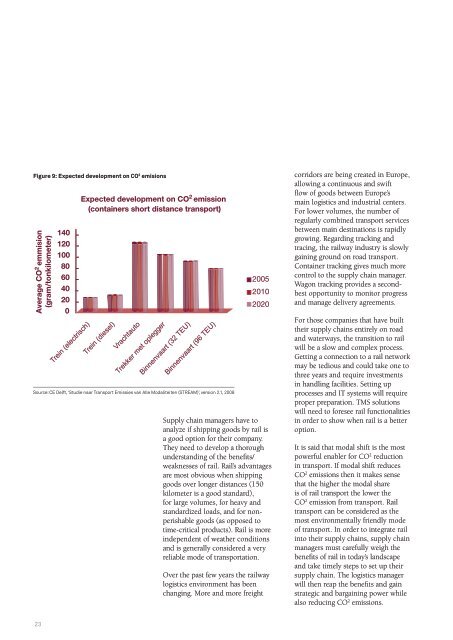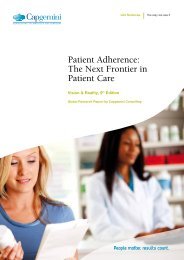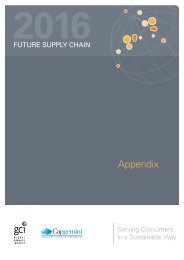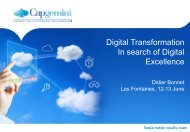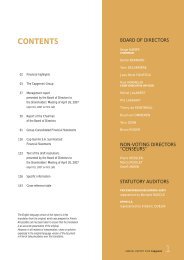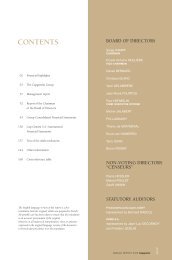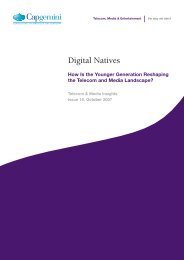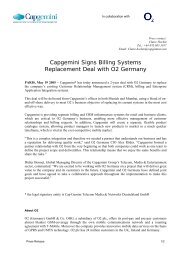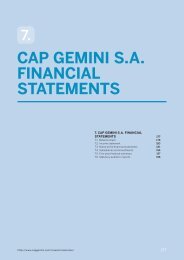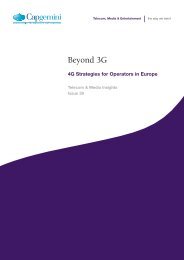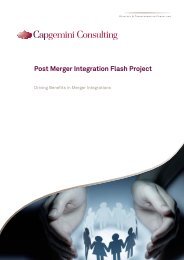Transportation Management Report 2011 - Capgemini
Transportation Management Report 2011 - Capgemini
Transportation Management Report 2011 - Capgemini
Create successful ePaper yourself
Turn your PDF publications into a flip-book with our unique Google optimized e-Paper software.
Figure 9: Expected development on CO 2 emisions<br />
Average CO2 emmision<br />
(gram/tonkilometer)<br />
23<br />
140<br />
120<br />
100<br />
80<br />
60<br />
40<br />
20<br />
0<br />
Expected development on CO 2 emission<br />
(containers short distance transport)<br />
Source: CE Delft, ‘Studie naar Transport Emissies van Alle Modaliteiten (STREAM)’, version 2.1, 2008<br />
2005<br />
2010<br />
2020<br />
Supply chain managers have to<br />
analyze if shipping goods by rail is<br />
a good option for their company.<br />
They need to develop a thorough<br />
understanding of the benefits/<br />
weaknesses of rail. Rail’s advantages<br />
are most obvious when shipping<br />
goods over longer distances (150<br />
kilometer is a good standard),<br />
for large volumes, for heavy and<br />
standardized loads, and for nonperishable<br />
goods (as opposed to<br />
time-critical products). Rail is more<br />
independent of weather conditions<br />
and is generally considered a very<br />
reliable mode of transportation.<br />
Over the past few years the railway<br />
logistics environment has been<br />
changing. More and more freight<br />
corridors are being created in Europe,<br />
allowing a continuous and swift<br />
flow of goods between Europe’s<br />
main logistics and industrial centers.<br />
For lower volumes, the number of<br />
regularly combined transport services<br />
between main destinations is rapidly<br />
growing. Regarding tracking and<br />
tracing, the railway industry is slowly<br />
gaining ground on road transport.<br />
Container tracking gives much more<br />
control to the supply chain manager.<br />
Wagon tracking provides a secondbest<br />
opportunity to monitor progress<br />
and manage delivery agreements.<br />
For those companies that have built<br />
their supply chains entirely on road<br />
and waterways, the transition to rail<br />
will be a slow and complex process.<br />
Getting a connection to a rail network<br />
may be tedious and could take one to<br />
three years and require investments<br />
in handling facilities. Setting up<br />
processes and IT systems will require<br />
proper preparation. TMS solutions<br />
will need to foresee rail functionalities<br />
in order to show when rail is a better<br />
option.<br />
It is said that modal shift is the most<br />
powerful enabler for CO 2 reduction<br />
in transport. If modal shift reduces<br />
CO 2 emissions then it makes sense<br />
that the higher the modal share<br />
is of rail transport the lower the<br />
CO 2 emission from transport. Rail<br />
transport can be considered as the<br />
most environmentally friendly mode<br />
of transport. In order to integrate rail<br />
into their supply chains, supply chain<br />
managers must carefully weigh the<br />
benefits of rail in today’s landscape<br />
and take timely steps to set up their<br />
supply chain. The logistics manager<br />
will then reap the benefits and gain<br />
strategic and bargaining power while<br />
also reducing CO 2 emissions.


